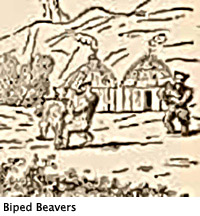Here’s the forty-eighth installment of LiteratEye, a series found only on The Art of the Prank Blog, by W.J. Elvin III, editor and publisher of FIONA: Mysteries & Curiosities of Literary Fraud & Folly and the LitFraud blog.
LiteratEye #48: Newspaper Nostalgia: Biped Beavers, Libidinous Man-Bats on the Moon
By W.J. Elvin III
January 22, 2010
 The New York Times, you may have noticed, plans to start charging for portions of its web content. One assumes the portions will be the those readers find most interesting.
The New York Times, you may have noticed, plans to start charging for portions of its web content. One assumes the portions will be the those readers find most interesting.
So then patronage will fall off, and with fewer readers there will be fewer advertisers, and so on until we hear the death rattle of yet another newspaper. Well, in the case of the Times it probably won’t be quite that bad, but the Internet era has certainly seen the downsizing or demise of quite a few news publications.
How bad is it? MSN Money lists newspaper subscriptions among its top ten things not to buy in 2010, citing the popular alternatives.
Which is too bad, because newspapers and news magazines have been a great vehicle for the perpetuation of hoaxes. No doubt our host, Joey Skaggs, is indebted to more than a few for taking the bait. In my own forty years or so in the news business I noticed a fairly cavalier attitude toward great stories that seemed at least a little fishy: “Print first, ask questions later.”
In the good old days, before newspapers got all goody-goody ethical, editors and reporters were among the top pranksters.
The sport got up its steam back in the 1830s. That was when Richard Adams Locke, an English journalist serving as editor of The New York Sun, sprang what is regarded as the greatest newspaper hoax of all time.
Locke concocted a story of life on the moon, attributed to a Scottish scientific journal.
Locke, a well-liked raconteur with forged educational credentials, had left England in something of a rush. That was not due to his marriage to his half-sister but because of his radical anti-establishment politics. Those views, according to one biographer, were “much in advance of the general political views of the period.”
The moon life discovery, credited to a renowned scientist of the day (who actually was trying out a new and ingenious type of telescope), included descriptions of natural wonders, bizarre animal life and, most amazing of all, the Vespertiliohomo or man-bat.
The bat people stood about four feet tall. From gestures observed via the new telescope, readers were told, it could be assumed they were capable of conversation. Due to what Locke termed “our terrestrial notions of decorum,” the man-bat’s nonchalant attitude toward public fornication was not gone into in detail.
Details were provided, however, regarding animal life including beavers that walked upright. Having domesticated fire, they lived in heated huts. There were also unicorns and horned bears, among other fabulous creatures.
The report was an international sensation, reprinted far and wide. It appeared at a time when the newspaper business was changing dramatically. Newspapers previously were mainly political organs. About the time when the hoax appeared, reduced prices made newspapers available to a much wider audience, coverage was extended to the police courts, horse races and prize fights, newsboys had begun hawking papers, and sensational headlines grabbed attention on the street.
Locke’s hoax won the praise of contemporaries including P.T. Barnum and Edgar Allan Poe, though Poe claimed it was really his idea. It is more likely Locke got the idea from a Scottish scientific journal that had published speculation about the possibility of life on the moon.
In fact, it appears that Poe plagiarized portions of his own moon-visit story that appeared in the Southern Literary Messenger. There have been quite a few moon-visit stories concocted, probably dating back to prehistoric bull sessions around a campfire.
Most people who read Locke’s tale believed it, apparently, at least for a while. Some helpfully reported having actually seen the scientific article upon which the report was based.
A delegation of astronomers arrived at the Sun’s offices from Yale asking to review the source article. They were given a merry run-around.
Locke didn’t benefit from his hoax in the long run. Stories he wrote thereafter were scrutinized as possibly being further hoaxes. He eventually left journalism and worked in a customs house.
For the most part, the account of the event I’ve relied on for this article is the book, The Sun and the Moon, by Matthew Goodman.
The Museum of Hoaxes includes a discussion of the moon visit article. The facts there run a little contrary to Goodman’s later work, a problem he touches on in his book. Wikipedia’s article seems to rely on the Museum of Hoaxes report.
Sure, you can still generate mass hysteria via the Internet, but with a zillion outlets vying for our attention, it’s not as easy as in the days when we were essentially at the mercy of the daily press. Oh, and one other thing that’s sad about the demise of newspapers: You can’t scatter electrons on the rug while you housebreak a puppy.
image: Museum of Hoaxes
(Copyright 2009 WJE, exclusive to The Art of the Prank, for reprint rights contact Literateye@gmail.com)
Check out previous LiteratEye episodes on The Art of the Prank.
